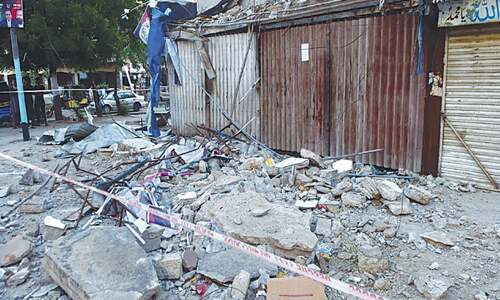LARKANA: “We have to use for all our needs the same saline and highly contaminated floodwater that inundates our village for the past three months and do without electricity,” said Abdul Hakeem Sakhani, whose family had taken shelter on Suprio Bund in the wake of flood.
The massive volume of floodwater coming from Balochistan through Hamal Lake, Flood Protective Bund, Main Nara Valley Drain and other large saline drains had forced a vast population to leave their abodes and take shelter on Suprio Bund, he said.
He and his family live in a ragtag shelter on the bund where most women complained that they had not received ration, tents, medical aid and financial assistance since the calamity hit them. “The winter is round the corner but we have no blankets to protect us save from cold,” they said.
Pir Mohammad Solangi, 60, said that he fractured his hip bone and was unable to go to hospital due to unbearable pain. A government official was so moved at his painful sight he assured him that both the doctor and medicines would reach him shortly.
Most areas without electricity, people have to use highly contaminated water for all purposes
Sikandar Lashari, operator of pumping station at Zero Point, said that 25 pumps were installed but only 12 were draining out the huge volume of water coming from the cuts and breaches in FP Bund, Hamal Lake and a host of Wapda SCARP drains. The machines needed uninterrupted supply of electricity to run round the clock but they operated only eight hours a day, he said.
Tarique Abro, executive engineer of SCARP, said that floodwater could not be pumped out in electricity issue was not resolved. The stagnant floodwater was being released through pumps into MNVD which carried it to Manchhar Lake, said the operator.
The government’s teams were busy conducting survey of damaged houses, crops, communication and others necessities for assessment of compensation but the marooned people questioned the government’s capacity to address multiple issues that had surfaced in the aftermath of unprecedented rains and flood.
Internally displaced persons from the flooded villages of Abdulllah Chandio, Khatir Khan, Pir Saleh Shah, Adho Khan Lashari, Laskhar Khan, Hussain Odhano, Moha-mmad Ibrahim Sakhani, Kamal Khan, Kariyo Sabbar Khan and several other settlements complained about dismally slow pace of drainage of water.
Azim Lashari and Safar Chandio said that 10 to 12 dehs were flooded while Jonani and Hamal dehs were completely devastated. If Main Ghar Pumping station ran round the clock water would hopefully recede within a month’s time, they said.
Unfortunately, despite Sindh High Court’s directives the Sukkur Electric Power Company did not ensure uninterrupted power supply to the pumping station.
Larkana commissioner and Qambar-Shahdadkot deputy commissioner vowed to write to the Sepco chief executive in this regard.
“We don’t know how will look after our families, cultivate our farmland and cope with this multidimensional crisis,” said people in Ali Bakhsh Chandio village near Nasirabad town.
Around 20 villages in the vicinity had b without electricity since 2010, they said.
The floodwater should either be routed through Dhamraho Wah or big dewatering pumps be installed to drain out water,” said the villagers.
Water from Faizo canal and Gul Mohammad canal be channelised through Badah drain of SCARP division as the floodwater was spread over miles and miles of land, they said.
Abdullah Chandio, an old farmer, said that if drainage was delayed on one pretext or the other, it would push them back to 20 years with unimaginable losses.
Haji Hussain Solangi said that stagnant water should be released into Badah drain as the only option to rekindle hope in peoples’ lives was rehabilitation of agriculture. Majority of flood victims demanded urgent help to survive through winter season and effective and sufficient medical aid to fight seasonal diseases.
Published in Dawn, November 22nd, 2022














































